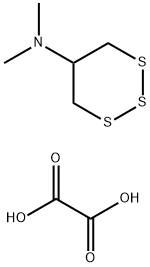SAFETY INFORMATION
| Signal word | Danger |
|---|---|
| Pictogram(s) |
 Skull and Crossbones Acute Toxicity GHS06  Environment GHS09 |
| GHS Hazard Statements |
H410:Hazardous to the aquatic environment, long-term hazard |
| Precautionary Statement Codes |
P264:Wash hands thoroughly after handling. P264:Wash skin thouroughly after handling. P270:Do not eat, drink or smoke when using this product. P273:Avoid release to the environment. P280:Wear protective gloves/protective clothing/eye protection/face protection. P301+P310:IF SWALLOWED: Immediately call a POISON CENTER or doctor/physician. |
COMPUTED DESCRIPTORS
| Molecular Weight | 271.4 g/mol |
|---|---|
| Hydrogen Bond Donor Count | 2 |
| Hydrogen Bond Acceptor Count | 8 |
| Rotatable Bond Count | 2 |
| Exact Mass | 271.00067142 g/mol |
| Monoisotopic Mass | 271.00067142 g/mol |
| Topological Polar Surface Area | 154 Ų |
| Heavy Atom Count | 15 |
| Formal Charge | 0 |
| Complexity | 152 |
| Isotope Atom Count | 0 |
| Defined Atom Stereocenter Count | 0 |
| Undefined Atom Stereocenter Count | 0 |
| Defined Bond Stereocenter Count | 0 |
| Undefined Bond Stereocenter Count | 0 |
| Covalently-Bonded Unit Count | 2 |
| Compound Is Canonicalized | Yes |
PRODUCT INTRODUCTION
description
Thiocyclam oxalate is an oxalate salt resulting from the formal reaction of equimolar amounts of thiocyclam and oxalic acid. A nicotinic acetylcholine receptor agonist, it was used as a broad-spectrum insecticide. It is not approved for use within the European Union. It has a role as an agrochemical, a nicotinic acetylcholine receptor agonist and an insecticide. It contains a thiocyclam(1+) and an oxalate(1-).
